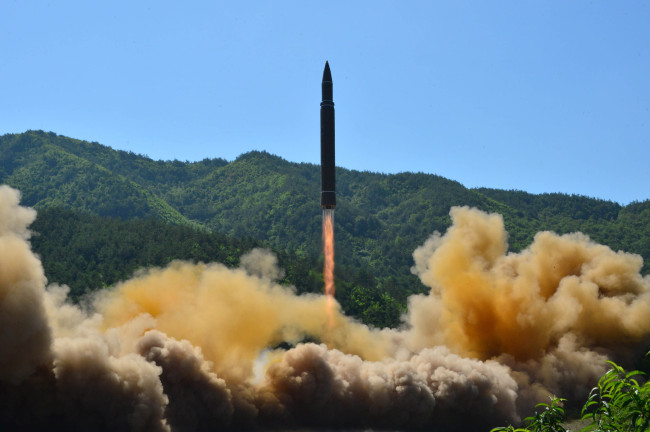Doubts persist over NK’s ICBM re-entry technology
By Jung Min-kyungPublished : July 31, 2017 - 17:23
With two successful missile launches in July, North Korea has showcased its ability to obtain the range required for intercontinental ballistic missiles. However, a major hurdle remains for North Korea to prove it can actually hit targets on the US mainland: re-entry technology.

Considered to be the final component of nuclear-tipped intercontinental ballistic missiles, the technology is crucial to ensuring the missiles withstand extreme temperatures and pressure when re-entering the Earth’s atmosphere. Without it, the missile could spring back to outer space or explode in midair.
Despite the North’s claim that the recent missile tests -- launches of the Hwasong-14 on July 4 and its extended version on Friday -- proved it had reliable re-entry technology, controversy persists over whether this is the case.
South Korean’s Ministry of National Defense and missile experts maintain that it is too early to determine whether the North has secured the technology, but some politicians and analysts suggest Pyongyang may have cleared the hurdle, particularly through Friday’s ICBM launch.
“It is fair to say that North Korea has already secured re-entry technology for nuclear warheads,” said Rep. Kim Young-woo of the minor opposition Bareun Party, who serves as a chairman of the National Assembly’ national defense committee.
Citing NHK footage of an ICBM falling into the waters off Japan’s island Hokkaido, the lawmaker suggested that the missile’s warhead might have endured extreme heat and pressure because the flash of the light emitted by the projectile was “not dispersed,”
Kim also said that North Korea might have perfected the technology to accurately control missile trajectory, saying Pyongyang successfully delivered the missile to an area some 170 kilometers from Hokkaido, in a deliberate process that requires advanced navigation system.
Japanese newspaper Asahi Shimbun, citing military analysts, introduced similar arguments that North Korea has made “significant progress” in re-entry technology. Unlike the previous Hwasong-14 test, the warhead of the ICBM fired Friday fell into the water without exploding in the re-entry phase, it added.
But the South Korean Ministry of National Defense remains cautious on such views. “It’s a bit too early to determine if Friday’s ICBM launch showed (a successful) re-entry test,” Defense Minister Song Young-moo told lawmakers on Monday.
When North Korea fired the Hwasong-14, then-Defense Minister Han Min-koo was pessimistic as to whether the North had developed a workable re-entry vehicle, saying Pyongyang has yet to show the missile’s warhead can withstand temperatures of at least 7,000 degrees Celsius.
Seoul-based aerospace experts agreed the North has yet to secure reliable re-entry technology, even though it appears clear that Pyongyang has inched closer to the goal.
Jang Young-geun, a professor of aerospace and mechanical engineering at Korea Aerospace University, said that unless North Korea presents “hard evidence,” it is difficult to verify the North’s claims about a re-entry vehicle.
“From the perspective of an engineer, it is quite difficult to verify their claim unless they retrieve the missile that splashed down in the sea, which I think is quite unlikely. Plus, North Korea didn’t even mention the re-entry vehicle when they made the ICBM announcement yesterday,” said Jang.
Jang also noted that an ICBM would be met with a “completely different re-entry environment” when deliberately fired at a lofty angle, as the North has done with recent ICBM tests, compared to being launched at a normal angle during an actual attack.
By Yeo Jun-suk (jasonyeo@heraldcorp.com)





![[Herald Interview] 'Amid aging population, Korea to invite more young professionals from overseas'](http://res.heraldm.com/phpwas/restmb_idxmake.php?idx=644&simg=/content/image/2024/04/24/20240424050844_0.jpg&u=20240424200058)












![[KH Explains] Korean shipbuilding stocks rally: Real growth or bubble?](http://res.heraldm.com/phpwas/restmb_idxmake.php?idx=652&simg=/content/image/2024/04/25/20240425050656_0.jpg&u=)

